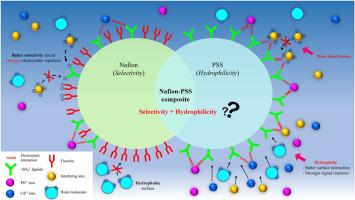当前位置:
X-MOL 学术
›
Anal. Chim. Acta
›
论文详情
Our official English website, www.x-mol.net, welcomes your
feedback! (Note: you will need to create a separate account there.)
Enhancement of electrode surface hydrophilicity and selectivity with Nafion-PSS composite for trace heavy metal sensing in electrochemical sensors
Analytica Chimica Acta ( IF 5.7 ) Pub Date : 2024-11-14 , DOI: 10.1016/j.aca.2024.343423 Chyh Shyang Ong, Qi Hwa Ng, Abdul Latif Ahmad, Siew Chun Low
中文翻译:

使用 Nafion-PSS 复合材料增强电极表面亲水性和选择性,用于电化学传感器中的痕量重金属传感
有效的电化学传感需要最佳的信号输出值和灵敏度,由于它们之间的关系违反直觉,这通常会带来挑战。为了增强这两个方面,本研究设计了一种改性的丝网印刷电极 (Nafion-PSS/SPE),该电极由两种富含磺酸盐的聚合物(即 Nafion 和聚(4-苯乙烯磺酸钠)(PSS))形成的复合材料组成。Nafion-PSS/SPE 用于通过方波阳极溶出伏安法 (SWASV) 电化学测定铅 (Pb2+) 和镉 (Cd2+)。这种创新方法旨在提高复杂基质的检测限和整体分析性能。(84)
亲水性 PSS 的添加可积极改善 Nafion-PSS/SPE 的表面润湿性,水接触角分析证实了这一点。尽管润湿性有所提高,但改性后的传感器对重金属离子保持了高选择性。循环伏安法 (CV) 显示阳离子的电化学活性表面积 (ECSA) 较大 (0.5646 cm2),阴离子的 ECSA 相对较低 (0.3221 cm2)。在优化条件下,Pb2+ 和 Cd2+ 的剥离响应分别在 0.025–0.7 ppm 和 0.0125–0.4 ppm 的浓度范围内表现出线性。改进后的传感器达到的检测限为 6.478 ppb (Pb2+) 和 5.277 ppb (Cd2+)。观察到的增强可归因于以下因素,包括磺酸盐配体(Nafion 和 PSS)的存在、增强的润湿性 (PSS) 和表面选择性 (Nafion)。此外,即使存在复制农药行业流出物成分的干扰离子,Nafion-PSS/SPE 对目标 Pb2+ 和 Cd2+ 离子也表现出卓越的选择性。(148)
这项工作提出了一种简单的丝网印刷技术,有可能用于重金属传感设备的批量生产。此外,通过仔细检查改性传感器的表面特性,这项工作旨在提供关于所提出的改性方法如何帮助提高传感器检测性能的见解。(50)
更新日期:2024-11-19
Analytica Chimica Acta ( IF 5.7 ) Pub Date : 2024-11-14 , DOI: 10.1016/j.aca.2024.343423 Chyh Shyang Ong, Qi Hwa Ng, Abdul Latif Ahmad, Siew Chun Low

|
Background
Effective electrochemical sensing requires optimal signal output value and sensitivity, which often pose a challenge due to their counter-intuitive relationship. In order to enhance both aspects, this study designs a modified screen-printed electrode (Nafion-PSS/SPE) comprising a composite formed by two sulfonate-rich polymers, namely Nafion and poly(sodium 4-styrenesulfonate) (PSS). The Nafion-PSS/SPE was utilized in the electrochemical determination of lead (Pb2+) and cadmium (Cd2+) via square wave anodic stripping voltammetry (SWASV). This innovative approach aims to improve detection limits and overall analytical performance in complex matrices. (84)Results
The addition of hydrophilic PSS positively improves surface wettability of Nafion-PSS/SPE, as confirmed by water contact angle analysis. Despite the improved wettability, the modified sensor maintains a high selectivity towards heavy metal ions. Cyclic voltammetry (CV) reveals a large electrochemically active surface area (ECSA) for cations (0.5646 cm2) and a relatively low ECSA for anions (0.3221 cm2). Under optimized conditions, the stripping responses for Pb2+ and Cd2+ exhibited linearity within the concentration ranges of 0.025–0.7 ppm and 0.0125–0.4 ppm, respectively. The detection limits achieved by the modified sensor are 6.478 ppb (Pb2+) and 5.277 ppb (Cd2+). The enhancement observed can be ascribed to the following factors, including presence of sulfonate ligands (Nafion and PSS), enhanced wettability (PSS), and surface selectivity (Nafion). Furthermore, even in the presence of interfering ions replicating the composition of effluent from the pesticide industry, the Nafion-PSS/SPE showcases remarkable selectivity for the target Pb2+ and Cd2+ ions. (148)Significance
This work presents a facile screen-printing technique that could be potentially adopted for batch production of heavy metal sensing devices. Besides, by scrutinizing the surface properties of the modified sensor, this work aims to provide insights on how the proposed modification approach can help to improve the sensor's detection performance. (50)中文翻译:

使用 Nafion-PSS 复合材料增强电极表面亲水性和选择性,用于电化学传感器中的痕量重金属传感
背景
有效的电化学传感需要最佳的信号输出值和灵敏度,由于它们之间的关系违反直觉,这通常会带来挑战。为了增强这两个方面,本研究设计了一种改性的丝网印刷电极 (Nafion-PSS/SPE),该电极由两种富含磺酸盐的聚合物(即 Nafion 和聚(4-苯乙烯磺酸钠)(PSS))形成的复合材料组成。Nafion-PSS/SPE 用于通过方波阳极溶出伏安法 (SWASV) 电化学测定铅 (Pb2+) 和镉 (Cd2+)。这种创新方法旨在提高复杂基质的检测限和整体分析性能。(84)
结果
亲水性 PSS 的添加可积极改善 Nafion-PSS/SPE 的表面润湿性,水接触角分析证实了这一点。尽管润湿性有所提高,但改性后的传感器对重金属离子保持了高选择性。循环伏安法 (CV) 显示阳离子的电化学活性表面积 (ECSA) 较大 (0.5646 cm2),阴离子的 ECSA 相对较低 (0.3221 cm2)。在优化条件下,Pb2+ 和 Cd2+ 的剥离响应分别在 0.025–0.7 ppm 和 0.0125–0.4 ppm 的浓度范围内表现出线性。改进后的传感器达到的检测限为 6.478 ppb (Pb2+) 和 5.277 ppb (Cd2+)。观察到的增强可归因于以下因素,包括磺酸盐配体(Nafion 和 PSS)的存在、增强的润湿性 (PSS) 和表面选择性 (Nafion)。此外,即使存在复制农药行业流出物成分的干扰离子,Nafion-PSS/SPE 对目标 Pb2+ 和 Cd2+ 离子也表现出卓越的选择性。(148)
意义
这项工作提出了一种简单的丝网印刷技术,有可能用于重金属传感设备的批量生产。此外,通过仔细检查改性传感器的表面特性,这项工作旨在提供关于所提出的改性方法如何帮助提高传感器检测性能的见解。(50)


















































 京公网安备 11010802027423号
京公网安备 11010802027423号